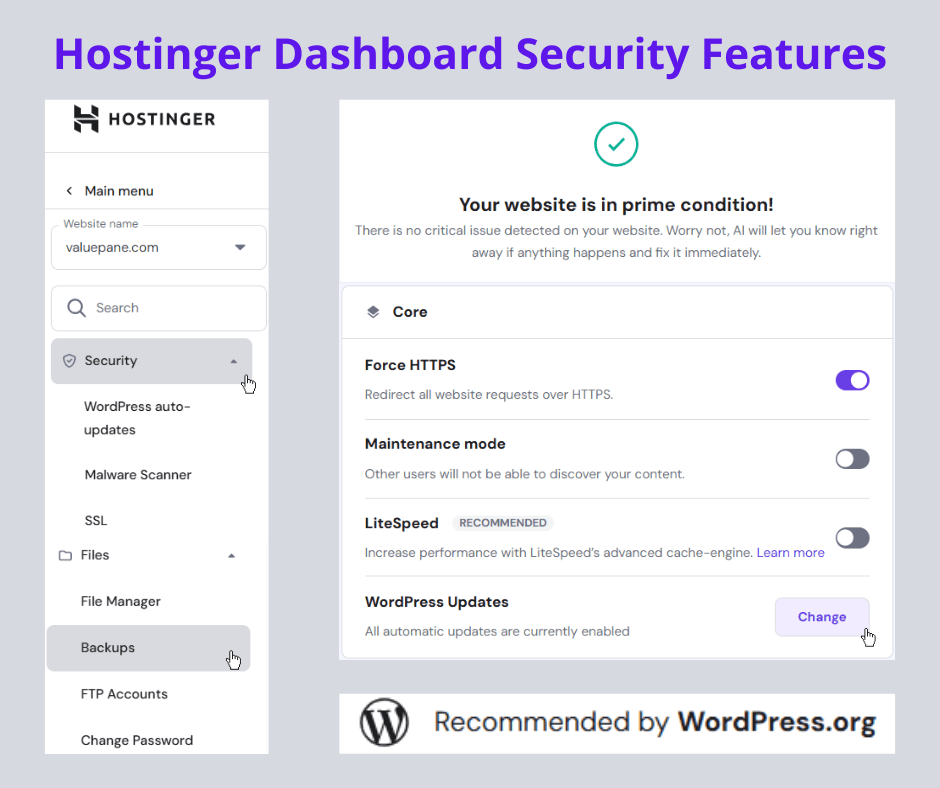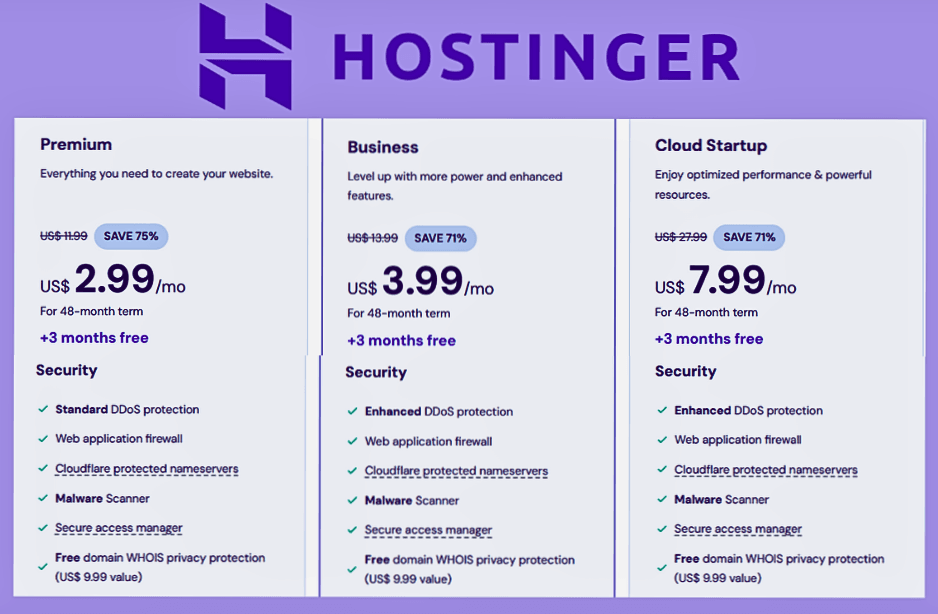Are you worried about hackers targeting your website? You should be, website security is a big deal. Whether you’re blogging in Nairobi or selling online in New York, you need web hosting security features to keep your site safe. This checklist covers must-have tools like SSL, malware protection, and backups, so you can protect your website from hackers.
In this checklist we will take you through each feature, from free SSL to 2FA, with real-world tips and a handy infographic. Using providers like Hostinger you’ll learn how to secure your site, no matter your tech skills.
Ultimately keeping your website safe and sound is of the utmost priority for both your visitors and yourself.

Table of Contents
The Importance of Website Security
Common Threats: Hacks, Malware, and DDoS
Hackers can steal data, inject malware, or crash your site with DDoS attacks. In 2024, 30% of small sites faced breaches. A shop in Lagos lost customer data to malware, hurting its reputation. Strong hosting security prevents these threats, keeping your visitors safe.
Impact on Business Reputation and Trust
A security breach can destroy your credibility. Customers expect secure sites—73% avoid non-HTTPS pages. A blogger in Sydney rebuilt trust after a hack by adding SSL, boosting traffic. Security isn’t just tech, it is about acquiring and keeping your audiences confidence.
Legal and Compliance Considerations
Data breaches can violate laws like GDPR, costing fines up to €20 million or 4% of global turnover, whichever is greater. A small business in London faced a $5,000 penalty for poor security. Hosting features like SSL and backups ensure compliance, protecting your site and wallet, no matter your location.
Essential Web Hosting Security Features
Free SSL Certificates for Data Encryption
SSL (Secure Sockets Layer) encrypts data between your site and users, showing HTTPS and a padlock.
Let’s Encrypt, offered by Hostinger, provides free SSL. A freelancer in Austin added SSL, improving SEO and trust. Ensure your host includes auto-renewing SSL for ease.

Malware Protection and Scanning
Malware scans detect and remove threats. SiteGround’s daily scans blocked a virus on a shop’s site in Canberra, saving its data. Hostinger includes weekly scans in regular plans and daily scans in premium plans. Look for real-time monitoring to catch issues before they spread.

DDoS Mitigation for Uptime
DDoS attacks flood your site, causing downtime. Hostinger, integrates Cloudflare security features to block these attacks, maintaining 99.9% uptime. A news site in Cape Town stayed online during a DDoS spike, thanks to SiteGround’s mitigation. This feature is non-negotiable for reliability ensuring that your site stays accessible globally.
The Role of Web Application Firewall (WAF)
How WAFs Protect Against Attacks
A WAF (Web Application Firewall) filters malicious traffic, like SQL injections or cross-site scripting. SiteGround’s WAF blocked 1,000+ attacks in a month for a blog in Mexico. Hostinger’s Cloudflare WAF is free, while WP Engine’s WAF is premium. WAFs are your site’s first of defense against hackers.
Configuring WAFs for Maximum Security
Enable WAF in your host’s dashboard—Hostinger’s takes 5 minutes. Customize rules to block suspicious IPs. A developer in Seoul tweaked Bluehost’s WAF, cutting hack attempts by 80%. Practice updating WAF rules regularly (say monthly) for effective protection and stay ahead of new threats.
Monitoring WAF Performance
Check WAF logs in your control panel to track blocked attacks. Hostinger’s dashboard shows 500+ blocks weekly. Tools like Sucuri monitor WAFs effectiveness, ensuring your site stays safe. Regular checks keep your WAF sharp.
Secure Server Configuration
Best Practices for Server Hardening
Hardening limits server vulnerabilities, disable unused ports, update software, and use strong passwords. Hostinger’s auto-updates patched a flaw for a retailer in Colombo. SiteGround’s secure servers use isolated accounts, limiting breach spread across users.
Regular Updates and Patch Management
Outdated software invites hacks. Hosting services like Bluehost, Hostinger, etc. provide auto-updates for WordPress and PHP. A portfolio site in Tokyo avoided a breach with SiteGround’s patches. Check your host’s update policy to protect your website from hackers automatically.
Role of Backups in Security
Backups let you restore your site after attacks or whenever you need. Hostinger’s weekly backups (daily on premium) saved a blog in Washington from ransomware. Use cPanel’s Backup Wizard or UpdraftPlus for WordPress, storing copies on Google Drive for redundancy.
you may be interested in How To Choose the Best Web Hosting For Beginners
Choosing a Secure Hosting Provider
| Provider | SSL | Malware Scans | WAF | Backups |
|---|---|---|---|---|
| Hostinger | Free | Weekly | Cloudflare | Weekly |
| SiteGround | Free | Daily | Custom | Daily |
| Bluehost | Free | Optional | Basic | Weekly |
| A2 Hosting | Free | Daily | Cloudflare | Daily |
Hostinger’s Security Offerings
Hostinger includes free SSL, weekly scans, and Cloudflare WAF, starting at $2.99/month. Its 2FA secures accounts, and backups save data. A student using Hostinger in Manila restored her site after a hack with the backup tool.

Comparing Bluehost, SiteGround, and A2 Hosting
SiteGround’s daily scans and WAF are top-tier but pricier ($14.99/month renewal). Bluehost’s basic security suits small sites, while A2 Hosting’s green servers add the eco-appeal.
A shop in Berlin picked SiteGround for its robust WAF, avoiding breaches. While not as robust as SiteGround, Hostinger’s security suits small sites with under 50,000 visitors.
Checking Provider Security Claims
Read user reviews on Reddit or Trustpilot to verify security claims. Test SSL with Qualys SSL Labs and scans with Sucuri. A blogger in Austria confirmed Hostinger’s 99.9% uptime with UptimeRobot, ensuring reliability. These tools validate your host’s promises.
Building a Security-First Hosting Plan
Creating Your Security Checklist
Use our checklist: enable SSL, WAF, 2FA, scans, and backups. Monitor with tools like Sucuri. A blogger in Delhi followed this, cutting hack risks by 90%. Review monthly to stay ahead of threats, no matter your site’s size.
Monitoring and Maintaining Site Safety
Check logs in your host’s dashboard. Hostinger’s shows hack attempts. Backup weekly via cPanel, UpdraftPlus, etc to Google Drive, DropBox or Mega. A retailer in Amsterdam restored her site in an hour after a malware hit, because she took daily backups. Stay vigilant to keep your site secure.
Training Your Team on Security
Educate your team on phishing and password hygiene. A startup in Mumbai held a 30-minute session, cutting login errors by 50%. Using free resources like Google’s cybersecurity guides or Hostinger’s blog to train staff, ensure that your site stays safe.
Conclusion
You can protect your website from hackers by using the right web hosting security features. From 2FA to backups, our checklist makes it easy, wherever you are. Choose providers like Hostinger, Bluehost or SiteGround, follow our tips, and keep your site safe and build trust.
